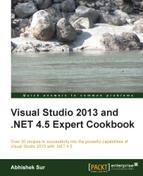In this chapter, we will cover the following topics:
- Working with various storage options in Windows Azure
- Creating, updating, and deploying a cloud service in Windows Azure
- Working with SQL Azure
- Working with HDInsight (Hadoop) for Big Data processing
- Working with Mobile Services in Windows Azure
Cloud computing is now one of the major metaphors for the Internet after Web 2.0 was deprecated. A cloud means the server, and when it is combined with computing, it means real-time computing on the server, scalability of infrastructure on the fly, adding a new infrastructure without changing the environment or without investing in new infrastructures, and training new personnel or licensing new software. Cloud computing encompasses a subscription-based pay per use service that in real time is capable of extending the existing capabilities.
Cloud computing comprises four service models:
- Software as a Service (SaaS): In this type of environment, a single piece of software is delivered to a thousand clients through web browsers in a multi-tenant architecture. From a customer's point of view, this means no upfront investment in servers or software licensing. On the contrary, the provider also needs minimum investment as there is one more application to maintain with almost no additional cost as such.
- Platform as a Service (PaaS): Another variant of SaaS is PaaS or Platform as a Service, which provides the basic computing platform and a solution stack as a service. In the case of Platform as a Service, the consumer creates software using tools and libraries from the provider. The provider here gives partial access to the platform using a portal, which the consumer needs to maintain.
- Infrastructure as a Service (IaaS): In the case of IaaS or Infrastructure as a Service, the whole machine is provided as a service. The virtual machines are created on the cloud, and the consumer needs to access it and configure everything on their own. The provider, on the other hand, creates a virtual machine and gives the user access to it with no maintenance on their side whatsoever.
- Network as a Service (NaaS): A variant of a service model called NaaS provides network/transport connectivity services between two intercloud networks. NaaS bridges two or more networks in a unified network as a whole; for example, NaaS services could be a Virtual Private Network (VPN), which bridges two geographically separate locations into a single local area network without compromising on security.
Cloud computing could be implemented using any of the preceding models; each of these differs with regards to the overall structure of the cloud, but each of them follows some basic characteristics and principles. They are as follows:
- Agility: This provides an agile-based infrastructure and resources.
- Application Programming Interface (API): This provides access to APIs to maintain, scale, and interact with the cloud environment.
- Elasticity and flexibility of the system: The main importance of cloud computing is scalability of the Web. Cloud provides a flexible system to deploy and maintain software with the support of elasticity that is based on the traffic.
- Measurable service: This is the payment per use.
- Individual use of resources: A user can use a resource anytime he or she desires. These resources include server space or server time, and they can be accessed without the need for human intervention from a client.
